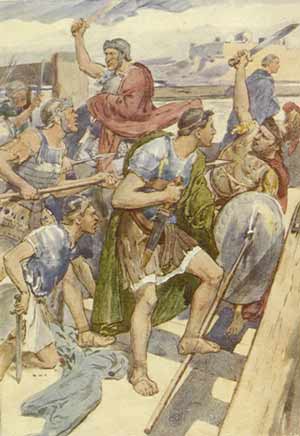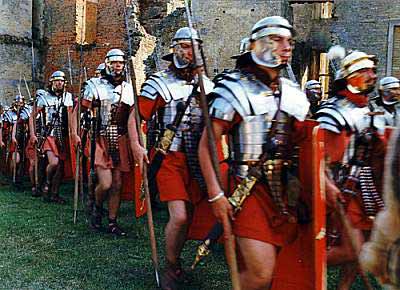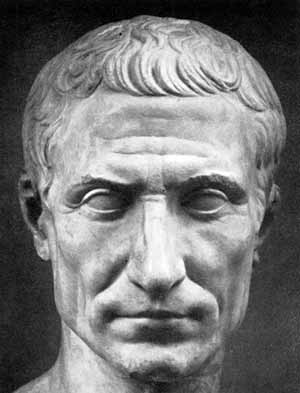
Octavian-Augustus, the first Roman emperor, who founded a military
dictatorship on the basis of the Roman Revolution
Neil Faulkner Archive | ETOL Main Page
Marxist History
Published online by Counterfire, 11 October 2010.
Copied with thanks from the Counterfire Website.
Marked up by Einde O’Callaghan for the Encyclopaedia of Trotskyism On-Line (ETOL).
Neil Faulkner looks at the Roman Revolution – a complex, distorted, century-long process of class struggle.

Octavian-Augustus, the first Roman emperor, who founded a military |
In 133 BCE (before the common era), the Roman politician Tiberius Gracchus was elected Tribune of the Plebs on a radical platform of land reform. Because of aristocratic opposition, he bypassed the Senate and passed his land bill into law by taking it direct to the Assembly of the Plebs. The following year, he was assassinated by a right-wing mob.
A new period of crisis had opened in Roman politics. It would last a century, passing through several phases of civil war, and at times would endanger the very survival of the Empire. It eventually brought about a radical restructuring of the ruling class, a bureaucratic recasting of the state, and the military dictatorship of the emperors.
 Political violence first erupted in 132 BCE |
The crisis arose from the inability of the city-state form inherited from the past to accommodate the new social forces created by world empire.
The patrician-plebeian nobility that controlled the Senate had ossified into an exclusive aristocratic caste hostile to ‘new men’. The senatorial elite’s monopoly of high office was resented by other sections of the aristocracy – minor senatorial families, second-division ‘equestrian’ families, and many Italian provincial families now involved in the government and commerce of empire. Inherited privilege was in contradiction with new social realities.
After the mid 2nd century BCE, the ruling class could not continue to rule in the old way. A minority favoured reform. Another minority were diehard reactionaries. The majority vacillated, but, preoccupied with the defence of property and privilege, usually came down on the side of the reactionaries in a crisis. Because of this, the reformers looked to wider forces to defeat senatorial opposition.
Fighting wars of conquest on distant frontiers was ruinous for small farmers in Italy. The Third Spanish War (154–133 BCE) consumed tens of thousands of soldiers. In a typical year, more than one in eight Roman citizens would be serving in the army. Many of those shipped to Spain were stuck there for years.
Farms at home went to ruin. Often they were bought up by big landowners. Roman citizens were then replaced by foreign slaves. The rich, explained a contemporary historian, ‘used persuasion or force to buy or seize property that adjoined their own, or any other smallholdings belonging to poor men, and came to operate great ranches instead of single farms. They employed slave-hands and shepherds on these estates to avoid having free men dragged off the land to serve in the army.’
The result was a double-edged social crisis. The decline of the Italian peasantry was draining the manpower pool on which the military vitality of the Republic depended. And a countryside filling with slaves was a major security problem.
The new slave economy was centred in Sicily and Southern Italy. Hundreds of thousands of war-captives were sold as slaves and set to work on aristocratic estates. Three times, slave revolt exploded across the region – in Sicily in 136–134 BCE, again in Sicily in 103–101 BCE, and finally in Italy itself in 73–71 BCE.
It is not an accident that the crisis of the Late Republic began during the First Sicilian Slave War. The immediate concerns of Tiberius Gracchus and the reformist wing of the ruling class were army recruitment and internal security. The debates took place against a backdrop of burning Sicilian villas.
Many demobilised soldiers and ruined small-farmers ended up in Rome. The fast-growing imperial city – fuelled by war booty, public-works projects, and aristocratic patronage and consumption – sucked in impoverished ‘surplus’ citizens. The Roman mob became a factor in politics.
The growth of empire had also changed the relationship between Roman and non-Roman in Italy. At least one in every two legionaries was not a Roman citizen at all, but a ‘Latin’ or an ‘Allied’ citizen. Increasingly, those who did an equal share of the fighting demanded an equal share in the spoils.
The franchise became an explosive issue. The Social War of 91–88 BCE was a full-scale civil war between Romans and Italians fought on the issue of equal political rights.
Italy was filled with combustible material: decayed senators, equestrian officials, and provincial-town gentry; small farmers ruined by debt; military conscripts demobilised into poverty after years at the front; the swelling mass of the city poor; and the many non-Romans who served the state but were excluded from its politics.
But the Roman Revolution – for revolution it became – had this peculiarity. No single class among the discontented was able to hegemonise the movement. None was able to establish leadership over the others by offering a coherent vision of a world transformed and a strategy for achieving it. None was able to provide a revolutionary alternative.
 The legions became the arbiters of power |
The aristocratic opposition feared the popular masses and threats to property. Small farmers feared the landless poor. Free citizens feared the competition of slaves. Romans feared the dilution of citizen privileges with the mass enfranchisement of Italians.
The popular movement was a multi-class alliance riddled with contradictions. It was this social character that made the Roman Revolution a complex, distorted, century-long process.
Reform through the Senate was blocked. The ‘Populists’ (populares: those who favoured the rule of ‘the People’) remained a minority of the ruling class, unable to bring about a ‘revolution from above’ against the entrenched opposition of the ‘Optimates’ (optimates or ‘best men’: those who favoured the rule of the Senate).

Julius Caesar, the greatest leader |
But without a revolutionary class able to break the impasse, only military force could decide the matter. The Roman Revolution therefore became a struggle of warlords.
Ambitious politicians sought prestigious and lucrative military commands. Booty and veterans became high-value counters in the game of Roman politics. The Revolution was transformed into civil wars between Populist and Optimate generals, Marius against Sulla, then Caesar against Pompey.
The decisive figure was Julius Caesar. A top-rank aristocrat, single-minded careerist, and murderous imperialist, he was also a brilliant commander, politician, and reformer. Caesar embodied the contradictions of the Roman Revolution whose principal protagonist he was.
Caesar was victorious in the Civil War of 49–45 BCE, but, being the leader of a popular movement rather than a revolutionary class, he was forced to seek an accommodation with the old order.
In the short run, this was impossible. The ruling class was too divided and embittered. Caesar attempted to straddle the contradictions through personal dictatorship. This provoked his assassination and a renewal of civil war.
The senatorial opposition (led by Brutus and Cassius) was quickly defeated by the leaders of Caesar’s faction (Antony and Octavian). But the Caesarian leaders then divided the empire between them and set about building rival power-bases. The final struggle of the Roman Revolution was therefore a factional civil war between Antony and Octavian.
Octavian, the Caesarian faction leader, became Augustus, the first Roman emperor. He founded a military dictatorship based on ‘new men’, moderate reform, and imperialist war. His regime represented the final transformation of an Italian city-state into a bureaucratically-administered global empire.
But even the most successful of the ancient empires contained the seeds of its own decay and eventual disintegration. We turn next to the crisis of late antiquity.
Neil Faulkner Archive | ETOL Main Page
Eleven Reasons to Fight
Last updated on: 14 February 2022